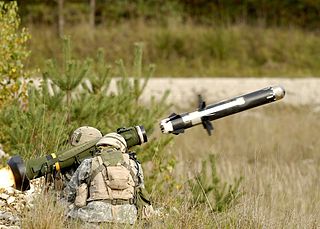
An anti-tank guided missile (ATGM), anti-tank missile, anti-tank guided weapon (ATGW) or anti-armor guided weapon is a guided missile primarily designed to hit and destroy heavily armored military vehicles. ATGMs range in size from shoulder-launched weapons, which can be transported by a single soldier, to larger tripod-mounted weapons, which require a squad or team to transport and fire, to vehicle and aircraft mounted missile systems.
The GATOR mine system is a United States military system of air-dropped anti-tank and anti-personnel mines developed in the 1980s to be compatible with existing cluster dispensers. It is used with two dispenser systems—the Navy 230 kg (500 lb) CBU-78/B and the Air Force 450 kg (1,000 lb) CBU-89/B. Additionally the mines are used with the land- and helicopter-based Volcano mine system.
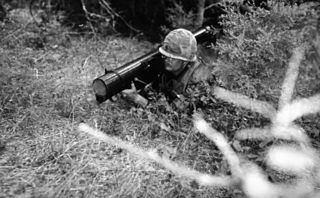
The LAW 80, regularly referred to as LAW 94 in British service, is a man-portable, disposable anti-tank weapon previously used by the British Army and a few other militaries.
The Panzerfaust 3 is a modern semi-disposable recoilless anti-tank weapon, which was developed between 1978 and 1985 and first entered service with the Bundeswehr in 1987. It was first ordered in 1973 to provide West German infantry with an effective weapon against contemporary Soviet armor, thereby replacing West Germany's aging PzF 44 Light Lanze launchers and the heavy Carl Gustaf 84 mm anti-tank recoilless rifle manufactured in Sweden.

The RAC 112 APILAS is a portable one-shot 112 mm recoilless anti-tank weapon, designed in France by GIAT Industries. Over 120,000 of the APILAS launchers have been produced, and they are in service with many countries.

The 9K112 Kobra is a SACLOS anti-tank missile system of the Soviet Union. It is fired from the 125 mm main guns of the T-64 and T-80 series of tanks. A newer design based on the same concept is the 9M119.
National Defence Complex (NDC), (Urdu: مستقرِ قومی دفاع), also known as National Development Complex or National Development Centre, is a Pakistani state-owned defence and aerospace contractor which is a division under the National Engineering and Scientific Commission (NESCOM). Its main setup is based in Fateh Jang, Rawalpindi, Pakistan.
The POMZ, POMZ-2 and POMZ-2M are three types of Soviet-made stake mounted anti-personnel fragmentation mine. The POMZ mine was used during the Second World War. It was superseded by the POMZ-2, and later by the improved POMZ-2M. These mines have been used in numerous conflicts, including the Vietnam War and the Korean War.

The TM-83 is a Soviet off-route anti-tank mine with a shaped charge, developed in 1983, and first shown publicly in 1993. The mine utilises the Misznay Schardin effect to create an armour-penetrating projectile, and is activated using its infrared and seismic sensors.

The AT2 mine is a scatterable anti-tank mine developed by Dynamit Nobel. It can be scattered from artillery rockets or from mine laying systems, and is in service with the British, German and Norwegian armed forces. AT2 mines were donated to Ukraine by Germany.
The VS-SATM1 is an Italian scatterable anti-tank landmine that was produced by Valsella Meccanotecnica SpA. The mine can be scattered by a GRILLO-128 man-portable single-tube launcher system or a VS-MDH helicopter based system. The mine has six pop-out fins which slow its descent and improve the dispersion characteristics.

The B-300 is a reusable man-portable anti-tank weapon system developed by Israel Military Industries in the late 1970s for use by the Israel Defense Forces. The B-300 can be carried and operated by a single operator and is effective to approximately 400 meters (1,312 ft). Pre-packaged munitions and simple operating mechanisms make the weapon quite versatile, permitting use by airborne, motorized, and ground troops alike. When defence publications first heard reports of the B-300 in the early 1980s, various reports stated in error that it was an Israeli improved and manufactured version of the Russian RPG-7.
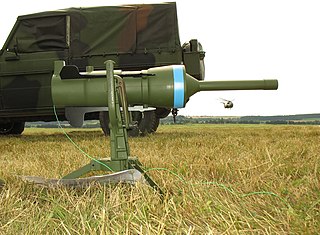
The PARM 1 (DM12) and its improved version (DM22) is a German off-route mine that fires a fin stabilized rocket. PARM stands for PanzerAbwehrRichtMine, anti-tank directional mine.
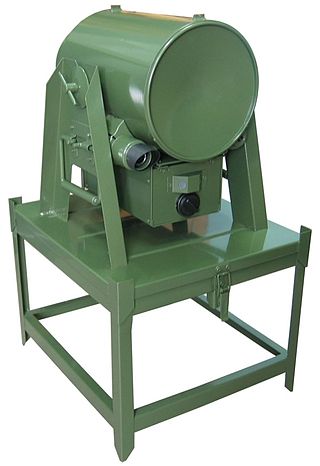
The MPB is a Polish off-route anti-tank mine. It was developed by BELMA with its partner Military Institute of Engineer Technology. The MPB consists of a metal cylinder filled with explosives, mounted horizontally in an adjustable frame. The mine is intended to be hidden from direct view of the intended target, off to the side of a probable vehicle route, usually a road, to attack the weaker armour on the sides and rear of a vehicle. The mine can be triggered by either a contact fuze or an influence fuze based on infrared and acoustic sensors, and is also fitted with an anti-handling device. When used with the passive infrared fuze, an acoustic sensor detects approaching vehicles and activates the infrared sensor, which triggers the mine at an optimal moment as the target passes. The mine can be programmed to self-destruct after either 1, 10 or 30 days have passed.

The T-72 is a Soviet-designed main battle tank that entered production in 1971. It replaced the T-54/55 series as the workhorse of Soviet tank forces. In front-line Russian service, T-72s are being upgraded or augmented by the T-90, itself a modernized version of the T-72B. The T-72 has been exported and produced in many countries.

Man-portable anti-tank systems are traditionally portable shoulder-launched projectile systems firing heavy shell-type projectiles, typically designed to combat protected targets, such as armoured vehicles, field fortifications and at times even low-flying aircraft.
The FT5 is a shoulder-launched, unguided and portable anti-tank rocket weapon. The weapon was built in South Africa by Somchem, a division of Denel based in Somerset West, now Rheinmetall Denel Munition. The weapon was designed with the primary function to provide soldiers with a weapon capable of destroying armoured fighting vehicles and modern main battle tanks. The weapon also has a secondary function of destroying bunkers and other fortifications.
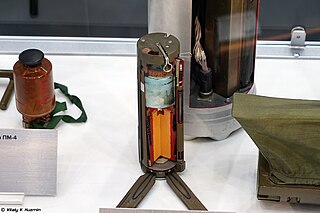
The POM-3 "Medallion" is a Russian bounding anti-personnel mine.
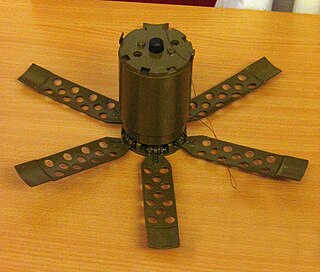
The POM-2 is a Soviet scatterable self-liquidating fragmentation anti-personnel mine. It has a mechanical fuze with tension-type target sensors BP-09S.

The PTM-1, also known as the PTM-1G, PTM-1S, and the PGMDM is a Soviet/Russian plastic-bodied anti-vehicle landmine. It is generally deployed by aircraft via cluster munition dispenser such as the KMGU munitions dispenser, helicopter or rocket artillery via the BM-21 or BM-27 rocket systems.













